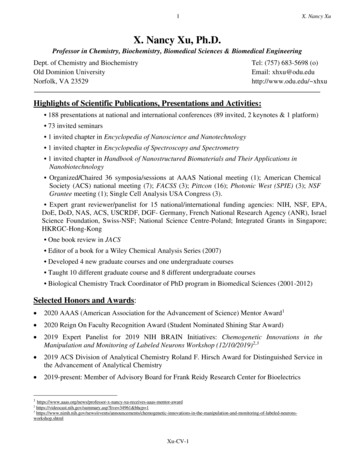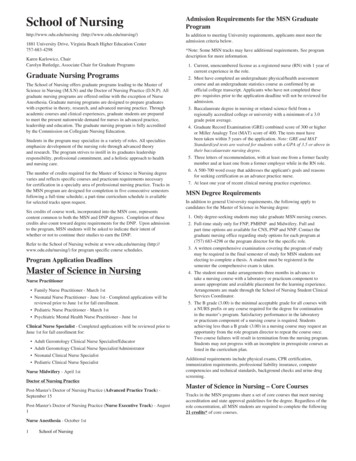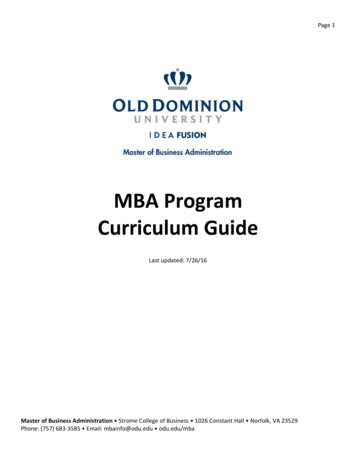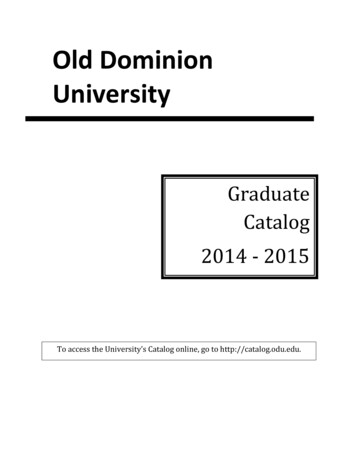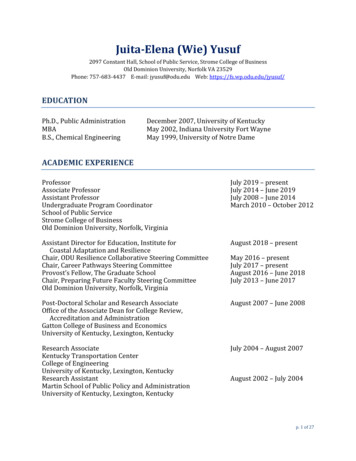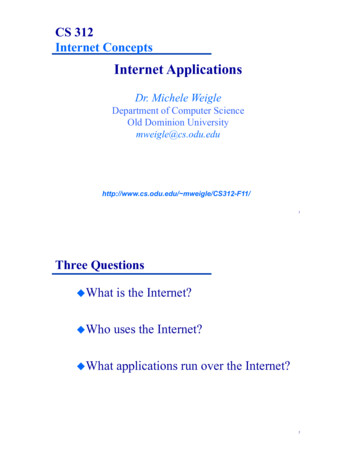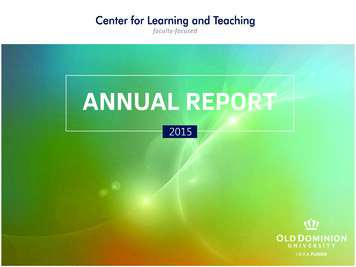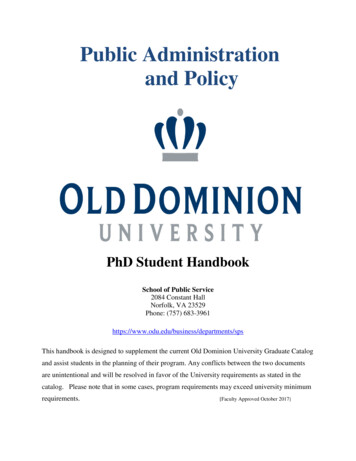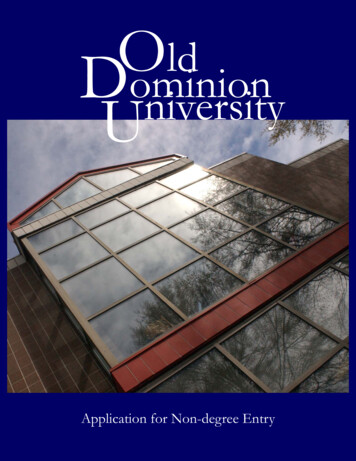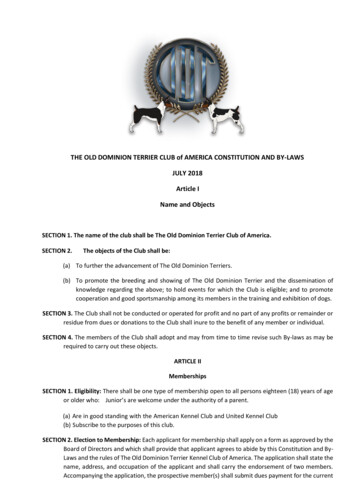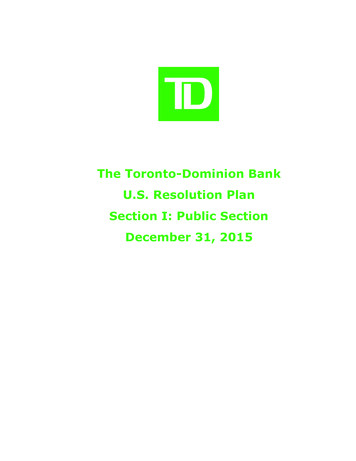
Transcription
The Toronto-Dominion BankU.S. Resolution PlanSection I: Public SectionDecember 31, 2015
THIS PAGE LEFT WAS LEFT BLANK INTENTIONALLY
Toronto-Dominion Bank Public SectionTable of ContentsTable of ContentsI.SUMMARY OF RESOLUTION PLAN .4A.B.C.D.E.F.G.H.I.J.K.NAME AND DESCRIPTION OF MATERIAL ENTITIES .7NAME AND DESCRIPTION OF CORE BUSINESS LINES .9SUMMARY FINANCIAL INFORMATION – ASSETS, LIABILITIES, CAPITAL AND MAJOR FUNDING SOURCES .11DESCRIPTION OF DERIVATIVE AND HEDGING ACTIVITIES .15MEMBERSHIPS IN MATERIAL PAYMENT, SETTLEMENT AND CLEARING SYSTEMS .16DESCRIPTION OF FOREIGN OPERATIONS .18MATERIAL SUPERVISORY AUTHORITIES.19PRINCIPAL OFFICERS .21RESOLUTION PLANNING CORPORATE GOVERNANCE STRUCTURE & PROCESS .23DESCRIPTION OF MATERIAL MANAGEMENT INFORMATION SYSTEMS .25HIGH LEVEL DESCRIPTION OF RESOLUTION STRATEGY .26Page 3
Toronto-Dominion Bank Public SectionI. Summary of Resolution PlanI.SUMMARY of RESOLUTION PLANResolution Plan RequirementsThis Public Section provides a summary of the Resolution Plan (“Plan”) developed by TheToronto-Dominion Bank ("TD" or “Parent”) for its Core Business Lines (“CBLs”) andMaterial Entities (“MEs”), including its principal U.S. Insured Depository Institution, TDBank, N.A. (“TDBNA”), as required by the following regulations: The Resolution Planning Rule (“Joint Rule”) jointly promulgated by the Board ofGovernors of the Federal Reserve System (“FRB”) and the Federal Deposit InsuranceCorporation (“FDIC”) implementing Section 165(d) (“165(d)”) of the Dodd-Frank WallStreet Reform and Consumer Protection Act (“Dodd-Frank”); and The FDIC’s Resolution Plan Rule for large insured depository institutions (“FDIC Rule”and, together with the Joint Rule, the “Rules”).Section 165(d) of Dodd-Frank ("Joint Rule") requires that each bank holding company(“BHC”) with USD 50 BN or more in total consolidated assets (“Covered Company”),such as the Parent, develop a Resolution Plan that describes the strategy for its orderlyresolution. The Joint Rule sets forth the specific requirements for resolution planning.Covered Companies that are foreign banking organizations1 are required to develop aResolution Plan for their U.S.-based operations and entities. Foreign-based CoveredCompanies with less than USD 100 BN in total U.S. non-bank assets, such as the Parent,are required to file Resolution Plans on or before December 31, annually. The initialfilings with both the FDIC and FRB were made on December 31, 2013. Pursuant to theRules, the Parent has developed its third U.S. Plan submission which was filed with FRBon or before December 31, 2015. Such Resolution Plans demonstrate how the MEs andCBLs can be resolved in a rapid and orderly manner, and in a way that mitigates risks tofinancial stability, in the event that the Covered Company faces material financialdistress and fails.The FDIC Rule requires that insured depository institutions with USD 50 BN or more intotal consolidated assets (a Covered Insured Depository Institution or “CIDI”), such asTDBNA, develop a Plan that describes the strategy for resolution of the CIDI in the eventof its failure. The strategy must minimize any losses to the Deposit Insurance Fund("DIF"), maximize the value of assets for creditors, and ensure ready access bydepositors to deposits. CIDIs with a foreign-based parent company with less than USD100 BN in total U.S. non-bank assets, such as TDBNA, are required to file ResolutionPlans annually on or before December 31. Pursuant to the FDIC Rule, TDBNA hasdeveloped its third U.S. Plan submission filed with FDIC on or before December 31,2015.1“Foreign banking organization” is defined as any foreign bank or company that is a BHC or istreated as a BHC under Section 8(a) of the International Banking Act of 1978.Page 4
Toronto-Dominion Bank Public SectionI. Summary of Resolution PlanOverview of The Toronto-Dominion Bank & its U.S. OperationsAs at October 31, 2015, the Parent was the second largest Canadian bank in terms ofmarket capitalization. TD Bank Group ("TDBG") is the sixth largest bank in NorthAmerica by branches and serves more than 24 million customers in three key businessesoperating in a number of locations in financial centers around the globe: CanadianRetail, including TD Canada Trust, TD Auto Finance Canada, TD Wealth (Canada), TDDirect Investing, and TD Insurance; U.S. Retail, including TD Bank, America's MostConvenient Bank , TD Auto Finance U.S., TD Wealth (U.S.) and an investment in TDAmeritrade; and Wholesale Banking, including TD Securities. TD also ranks among theworld's leading online financial services firms, with approximately 10.2 million activeonline and mobile customers. TD had CDN 1.1 TN in assets on October 31, 2015. TDtrades under the symbol "TD" on each of the Toronto Stock Exchange and the New YorkStock Exchange. The following are the three operating segments of the Parent:1. Canadian Retail: Canadian Retail provides a full range of financial products andservices to nearly 15 million customers in the Canadian personal and commercialbanking businesses, including credit cards, auto finance, wealth, and insurancebusinesses.2. Wholesale Banking: Operating under the brand name TD Securities, WholesaleBanking provides a wide range of capital markets, investment banking, andcorporate banking products and services to corporate, government, and institutionalclients in key global financial centers.3. U.S. Retail: Operating under the brand name, TD Bank, America’s Most ConvenientBank , U.S. Retail offers a full range of financial products and services to more than8 million customers in the bank's U.S. personal and commercial banking businesses,including U.S. credit cards, auto finance, and wealth management.The U.S.-based material operations of the Parent’s group (“U.S. Operations”) areconducted principally within the U.S. Retail and Wholesale Banking business segments.Events subsequent to 2014 Plan filingFor the 2015 Plan filing, TD Bank USA, N.A. ("TDBUSA") was identified as a MaterialEntity ("ME") and Strategic Card Programs ("SCP") was identified as a Core BusinessLine ("CBL") for the 165(d) Resolution Plan.In addition, the FRB's Enhanced Prudential Standards ("EPS") rules require a foreignbanking organization ("FBO") with USD 50 BN in U.S. non-branch/agency assets to placeits U.S. subsidiaries underneath a top-tier U.S. Intermediate Holding Company ("IHC")by July 1, 2016. TD Group US Holdings LLC’s (“TDGUS”) was established on July 1,2015 and will be designated as TD's IHC by July 1, 2016. In the new organization,TDGUS is the direct parent of TD Bank U.S. Holding Company (“TDBUSH”), whichincludes two principal Insured Depository Institution (“IDI”) subsidiaries, TDBNA andTDBUSA.Page 5
Toronto-Dominion Bank Public SectionI. Summary of Resolution PlanAlso of note, on May 26, 2015, TDBUSA and Nordstrom, Inc. ("Nordstrom") announcedan agreement under which TDBUSA will acquire substantially all of Nordstrom's existingU.S. Visa and private label consumer credit card portfolio. This acquisition was finalizedon October 1, 2015.The Joint Rule requires an analysis of the organization as of December 31, 2014. Assuch, the establishment of TDGUS and the acquisition of Nordstrom are not consideredin this year's plan nor are they expected to materially impact resolvability.As required by the December Guidance, the Resolution Plan incorporates two newstrategies with respect to TDBNA - an initial public offering strategy ("IPO Strategy"),which involves an IPO of the Bridge Depository Institution for TDBNA (“Bridge Bank”),and a Liquidation Strategy, which involves liquidating all of TDBNA’s assets. These newstrategies supplement existing strategies for full purchase and assumption (“P&A”) byan acquiring institution and multiple acquirers strategy. Further, the Resolution Planincludes an extensive quantitative and qualitative analysis to provide basis for adetermination which strategy would likely be least costly to the DIF.Page 6
Toronto-Dominion Bank Public SectionI. Summary of Resolution PlanA. Name and Description of Material EntitiesA. Name and Description of Material EntitiesUnder the Joint Rule, Material Entities of foreign-based Covered Companies, such as theParent, are defined as legal entities that are significant to the activities of a CBL, aCritical Operation or a Critical Service for the CIDI and that are domiciled in the U.S. orthat conduct material operations in the U.S. The Parent and the CIDI identified MEs byemploying a comprehensive top-down and bottom-up approach, analyzing assets andliabilities, revenue, profit, contribution to franchise value, funding and operationalinterconnections.The following were identified as MEs under the Joint Rule:TD Bank, N.A.TDBNA is one of two principal IDI subsidiaries of TDBUSH, which the U.S. Retail segmentuses to conduct its banking operations business. TDBNA, a national bank, is the Parent’sprimary insured depository institution in the U.S. and is an ME for the 165(d) ResolutionPlan, as well as the CIDI for the FDIC Resolution Plan. TDBNA is one of the ten largestbanks in the U.S. by both deposits and assets.2 TDBNA provides customers with a fullrange of financial products and services at nearly 1,300 locations from Maine to Florida.TDBNA is an indirect wholly owned subsidiary of the Parent.TD Auto Finance LLCTD Auto Finance LLC (“TDAF”) is an operating subsidiary of TDBNA. TDAF providesflexible financing options to automotive retail customers through its auto dealer network.TD Bank USA, N.A.TDBUSA, a nationally chartered bank, is TD’s second principal IDI subsidiary of TDBUSH,which the U.S. Retail segment uses to conduct its banking operations business in theUnited States. TDBUSA does not directly offer retail products and does not maintain atraditional branch network. TDBUSA’s principal activities are offering money marketdeposit services for the benefit of TD Ameritrade’s (“TDAMT’s”) brokerage customers,providing corresponding banking services to TDAMT and providing credit card services toretail customers under an agreement with Target, as well as for Nordstrom, whoseprivate label credit card portfolio was acquired by TDBUSA in October of 2015. TDBUSAis the issuer and owner of the credit card accounts and related receivables that areoffered to Target's (and Nordstrom's) customers. TDBUSA is supported by employeesand business units of TDBNA that perform services specified under a Master ServiceAgreement ("MSA") between TDBNA and TDBUSA.2SNL Financial as of December 31, 2014; universe includes U.S.-based banks.Page 7
Toronto-Dominion Bank Public SectionI. Summary of Resolution PlanA. Name and Description of Material EntitiesTD Securities (USA) LLCTD Securities (USA) LLC (“TDS USA”) is an indirect wholly owned subsidiary of TDHoldings. TDS USA operates as a broker-dealer in U.S. debt, corporate debt, equity andmoney market securities. TDS USA also acts as principal and an agent in theunderwriting, distribution and private placement of debt and equity securities and otherfinancial instruments.The Toronto-Dominion Bank, New York BranchThe Parent maintains a branch in the State of New York (“NY Branch”) that, among otherthings, supports U.S. Wholesale Banking activities.Toronto Dominion Holdings (U.S.A.), Inc.Toronto Dominion Holdings (U.S.A.), Inc. (“TD Holdings”) is a non-bank holdingcompany and the parent of TDS USA. TD Holdings is a wholly owned, direct subsidiary ofthe Parent.The Toronto-Dominion BankAlthough domiciled in Canada, the Parent has been identified as an ME for purposes ofboth the Joint and FDIC Rules because of the services it provides to the U.S.-based MEsand CBLs.Under the FDIC Rule, MEs are legal entities that are significant to a CBL or CriticalService of the CIDI. TDBNA is the CIDI, and TDAF and the Parent were identified as MEsfor the CIDI Plan.Page 8
Toronto-Dominion Bank Public SectionI. Summary of Resolution PlanB. Name and Description of Core Business LinesB. Name and Description of Core Business LinesCBLs are defined under the Joint Rule and the FDIC Rule as those business lines that,upon failure, would result in a material loss of revenue, profit or franchise value to theCovered Company or the CIDI, respectively. The Parent used qualitative and quantitativecriteria to determine which business lines within its U.S. Operations were material anddesignated them as CBLs for purposes of the Joint Rule. A similar process was applied toidentify CBLs for the CIDI for the FDIC Rule.Retail DepositsAs part of the U.S. Retail segment, Retail Deposits offers a large variety of checking andsavings products, along with money market accounts and certificates of deposits, toindividual customers.Retail LendingAs part of the U.S. Retail segment, Retail Lending provides various mortgage andconsumer lending products.Business Banking Deposit ProductsAs part of the U.S. Retail segment, Business Banking Deposit Products offers checkingand savings products and associated cash management products and services tocommercial, government and small-business customers.Commercial Lending - RegionalAs part of the U.S. Retail segment, Commercial Lending - Regional sells and managescredit and ancillary products for regionally based commercial banking customers.Commercial Lending - SpecialtyAs part of the U.S. Retail segment, Commercial Lending - Specialty handles the needs ofU.S. commercial customers with special borrowing needs in discrete lending categories:Large Corporate, Healthcare, Corporate Real Estate, Asset Based Lending, EquipmentFinance and Dealer Commercial Services.TDAF CBLAs part of the U.S. Retail segment, TDAF CBL provides indirect auto financing for newand used vehicles through auto dealerships across the U.S.Strategic Card Programs ("SCP")TDBUSA completed the purchase of Target’s U.S. Visa and private label consumer creditcard accounts on March 13, 2013. TDBUSA formed the SCP CBL to operate its creditcard program with retailers, including the Target program. The SCP CBL operates as adistinct operating unit within TDBUSA. Target is responsible for many elements ofPage 9
Toronto-Dominion Bank Public SectionI. Summary of Resolution PlanB. Name and Description of Core Business Linesoperations and customer service. TD controls risk management policies, overseesregulatory compliance and bears all costs related to funding the portfolio. The SCPportfolio is expected to grow in 2016 with the October 2015 acquisition of the Nordstromprivate label credit card business which will operate independent of Target.Fixed Income, Currencies & Metals (“FICM”)As part of the U.S. Operations of the Wholesale Banking segment, the key products ofthe FICM CBL include U.S. Treasuries, agency debentures, swaps, municipal bonds,corporate bonds, foreign exchange and repurchase agreements.It should be noted that SCP and FICM are CBLs unique to the FRB 165(d) Resolution Planfiling, whereas each of the other named CBLs are applicable for both the FRB filing aswell as the CIDI Resolution Plan under the FDIC filing rule.Page 10
Toronto-Dominion Bank Public SectionI. Summary of Resolution PlanC. Summary Financial InformationC. Summary Financial Information – Assets, Liabilities,Capital and Major Funding SourcesThe sections below present summary financial information for the Parent, the CoveredCompany under the Joint Rule, and TDBNA, the CIDI under the FDIC Rule. Auditedconsolidated financial statements of the Parent are available on the Parent’s investorrelations website at www.td.com/investor.The Toronto-Dominion Bank - Summary Financial InformationThe following exhibit presents a summary of the Parent’s consolidated balance sheet asof October 31, 2014. The Parent’s financial statements conform to International FinancialReporting Standards.Exhibit I.C.1: The Toronto-Dominion Bank (in Canadian Dollars millions)Summary Consolidated Balance SheetAs of October 31, 2014AssetsCash and due from banks2,781Interest-bearing deposits with banks43,773Trading loans, securities, and other101,173Derivatives55,363Financial assets designated at fair value4,745Available-for-sale securities63,008Held-to-maturity securities56,977Securities purchased under reverse repurchaseagreements75,031Loans, net of allowance for loan losesOther478,90962,982Total Assets944,742Liabilities and EquityTrading deposits59,334Derivatives50,776Securitization liabilities at fair value11,198Other financial liabilities designated at ted notes and debentures7,785Page 11
Toronto-Dominion Bank Public SectionI. Summary of Resolution PlanC. Summary Financial InformationSummary Consolidated Balance SheetAs of October 31, 2014Liability for preferred shares0Liability for capital trust securities0Total Liabilities888,511Total Equity56,231Total Liabilities and Equity944,742Source: The Toronto-Dominion Bank 2014 Annual Report as of October 31, 2014 (Consolidated Balance Sheet)Major Funding SourcesThe Parent has access to a wide variety of short and long-term unsecured and securedfunding sources including securitization channels that it uses to meet fundingrequirements. A key approach to managing funding activities is to maximize the use ofstable retail sourced deposits raised through personal and commercial banking channels.The exhibit below illustrates the Parent's large base of personal and commercial,domestic wealth, and TD Ameritrade sweep deposits (collectively P&C deposits) thatmake up over 70% of total funding excluding securitization.Exhibit I.C.2: The Toronto-Dominion Bank (in Canadian Dollars billions)Major Funding SourcesAmountP&C deposits – Canadian Retail (including domestic Wealth business)273.2P&C deposits – U.S. Retail227.1Other Deposits1.1Total501.4Source: The Toronto-Dominion Bank 2014 Annual Report; as of October 31, 2014; 2014 ManagementDiscussion and AnalysisCapital ManagementThe table below shows the Parent’s regulatory capital ratios as compared to the targetsof the Canadian Office of the Superintendent of Financial Institutions (“OSFI”), as ofOctober 31, 2014.Parent’s Basel III Tier 1 capital ratio was 10.9% as of October 31, 2014.Exhibit I.C.3: The Toronto-Dominion Bank Regulatory CapitalRegulatory Target1ActualTier 1 Capital Ratio9.5%10.9%Total Capital Ratio11.5%13.4%RatiosSource: The Toronto-Dominion Bank 2014 Annual Report1Targets established by OSFI, effective first quarter of 2014Page 12
Toronto-Dominion Bank Public SectionI. Summary of Resolution PlanC. Summary Financial InformationTD Bank, N.A. – Summary Financial InformationThe following table displays a summary consolidated balance sheet for TDBNA as ofDecember 31, 2014.Exhibit I.C.4: TD Bank, N.A. Summary Balance Sheet (in USD millions)Summary Consolidated Balance SheetAssetsCash and Cash Equivalents15,303Securities78,469Loans110,878Fixed Assets2,669Goodwill and Intangible Assets13,437Other Assets9,524Total Assets230,280Liabilities and EquityDeposits192,259Other Borrowings4,918Other Liabilities2,490Total Liabilities199,667Total Equity30,613Total Liabilities and Equity230,280Source: Schedules RC
Ameritrade; and Wholesale Banking, including TD Securities. TD also ranks among the world's leading online financial services firms, with approximately 10.2 million active online and mobile customers. TD had CDN 1.1 TN in assets on October 31, 2015. TD trades under the symbol "TD" on each
